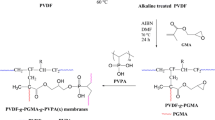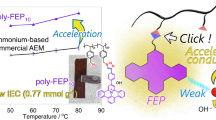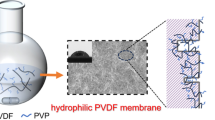Abstract
An expanded polytetrafluoroethylene (ePTFE) membrane was modified with an interpenetrating network of cross-linked poly(4-vinylpyridine) (PVP), a pH-responsive, nucleophilic polymer. Stirred reactor testing performed in buffered acidic conditions confirmed that PVP is a suitable catalyst to break down diisopropyl fluorophosphate (DFP), a commonly used nerve agent surrogate. The presence of the PVP interpenetrating network on the ePTFE membrane was established using Raman spectroscopy and thermogravimetric analysis. Goniometric measurements of average contact angles greater than 120° performed post-modification confirmed that the ePTFE membrane retained its hydrophobic properties. Utility of the ePTFE/PVP membrane was assessed by subjecting samples to DFP vapor permeation using the vial-in-vial method. The pH response of modified membranes having PVP loadings high enough to enable penetration of water was tested using cyclic voltammetry and electrochemical impedance spectroscopy. Changes in peak current and electron transfer resistance, R ET, corresponding with pH revealed that the ePTFE/PVP membranes are potential candidates for self-decontamination and electrochemical sensing. Finally, nanoscale characterization of the responsive membranes using atomic force microscopy was performed via the Derjaguin approximation, which treats the surface-confined polymer as a brush. Analysis established that the average brush length increased from 60 to 70 nm in response to a pH decrease from 7 to 4.










Similar content being viewed by others
References
Partington JR (1999) A history of Greek fire and gunpowder. Johns Hopkins University Press, Baltimore
Cornwell J (2003) Hitler’s Scientists. Penguin Group (USA) Inc., New York
Cirincione J, Wolfsthal JB, Rajkumar M (2005) Deadly Arsenals. Carnegie Endowment for Int’l Peace, Washington
Rosman Y, Eisenkraft A, Milk N et al (2014) Lessons learned from the Syrian sarin attack: evaluation of a clinical syndrome through social media. Ann Intern Med 160(9):644–648. doi:10.7326/M13-2799
Okumura T, Hisaoka T, Yamada A et al (2005) The Tokyo subway sarin attack–lessons learned. Toxicol Appl Pharmacol 207(2):471–476. doi:10.1016/j.taap.2005.02.032
Ellison DH (2008) Handbook of chemical and biological warfare agents. CRC Press, Taylor and Francis Group, Boca Raton
Arca VJ, Marshall SM, Lake WA, Fedele PD (1999) Chemical protective clothing for law enforcement patrol officers and emergency medical services when responding to terrorism with chemical weapons. ECBC-TR-131, Defense Technical Information Center, Fort Belvoir, VA
National Fire Prevention Association (2012) NFPA #1994 standard on protective ensembles for first responders to CBRN terrorism incidents
Tam TK, Ornatska M, Pita M, Minko M, Katz E (2008) Polymer brush-modified electrode with switchable and tunable redox activity for bioelectronic applications. J Phys Chem C 112(22):8438–8445. doi:10.1021/jp801086w
Tam TK, Zhou J, Pita M, Ornatska M, Minko M, Katz E (2008) Biochemically controlled bioelectrocatalytic interface. J Am Chem Soc 130(33):10888–10889. doi:10.1021/ja8043882
Bromberg L, Su X, Martis V, Zhang Y, Hatton TA (2016) Self-decontaminating fibrous materials reactive toward chemical threats. Appl Mater Interfaces 8(27):17555–17564. doi:10.1021/acsami.6b05241
Rajagopalan S, Koper O, Decker S, Klabunde KJ (2002) Nanocrystalline metal oxides as destructive adsorbents for organo-phosphorus compounds at ambient temperatures. Chem Eur J 8(11):2602–2607. doi:10.1002/1521-3765(20020603)8:11<2602:AID-CHEM2602>3.0.CO;2-3
Salter WB, Owens JR, Hayn R, McDonald R, Shannon E (2009) N-chloramide modified Nomex as a regenerable self-decontaminating material for protection against chemical warfare agents. J Mater Sci 44(8):2069–2078. doi:10.1007/s10853-008-3114-z
Singh A, Lee Y, Dressick WJ (2004) Self-cleaning fabrics for decontamination of organophosphorous pesticides and related chemical agents. Adv Mater 16(23–24):2112–2115. doi:10.1002/adma.200400660
Wagner G, Yang Y (2002) Rapid nucleophilic/oxidative decontamination of chemical warfare agents. Ind Eng Chem Res 41(8):1925–1928. doi:10.1021/ie010732f
Strack G, Katz E (2012) Information security systems based on biomolecular information processing. Int J Unconv Comput 8(5):419–432. doi:10.3389/fncom.2016.00003
Creasy W, Fry R, McGarvey D, Hendrickson D, Durst HD (2010) Methods for chemical warfare agent reaction studies on reactive films using headspace GC/MS and high resolution magic angle spinning (HRMAS) NMR. Main Gr Chem 9(3–4):245–256. doi:10.3233/MGC-2010-0025
Salter WB, Lovingood DD, Creasy W, Owens JR (2016) Analysis of vaporous contaminants including low-volatility analytes permeating textiles at room temperature using headspace solid-phase microextraction GC–MS. Surf Interface Anal 48(1):47–50. doi:10.1002/sia.5887
Butt H-J, Cappella B, Kappl M (2005) Force measurements with the atomic force microscope: technique, interpretation and applications. Surf Sci Rep 59(1):1–152. doi:10.1016/j.surfrep.2005.08.003
Schmälzlin E, Moralejo B, Rutowska M et al (2014) Raman imaging with a fiber-coupled multichannel spectrograph. Sensors 14(11):21969–21980. doi:10.3390/s141121968
Nur H, Cornelius VJ, Benee LS, Mitchell JC, Day IJ, Snowden MJ (2009) Semi-quantitative analysis of the monomer composition in co-polymer microgels using solid state Raman and NMR spectroscopy. Analyst 134(7):1366–1372. doi:10.1039/b816792c
Bhushan B, Jung Y-C (1984) Koch K (2009) Micro-, nano- and hierarchical structures for superhydrophobicity, self-cleaning and low adhesion. Phil Trans R Soc A 367:1631–1672. doi:10.1098/rsta.2009.0014
Miwa M, Nakajima A, Fujishima A, Hashinoto K, Watanabe T (2000) Effects of the surface roughness on sliding angles of water droplets on superhydrophobic surfaces. Langmuir 16(13):5754–5760. doi:10.1021/la991660o
Verplanck N, Coffinier Y, Thomy V, Boukherroud R (2007) Wettability switching techniques on superhydrophobic surfaces. Nanoscale Res Lett 2:577. doi:10.1007/s11671-007-9102-4
Volkov D, Strack G, Halamek J, Katz E, Sokolov I (2010) Atomic force microscopy study of immunosensor surface to increase sensitivity and scale down size of ELISA-type sensors. Nanotechnology 21(14):145503. doi:10.1088/0957-4484/21/14/145503
Israelachvili JN (1992) Intermolecular and Surface Forces. Academic Press, Cambridge, 288–307
Buckles LC (1947) Hydrolysis Rate of GD. TCIR 373, Aberdeen Proving Ground, MD, ascension number ADB966291
Rádl Z, Opluštil F (1992) Kinetics and mechanisms of hydrolysis of fluorophosphates in aqueous solution. In: Fourth International Symposium on Protection against Chemical Warfare Agents, Stockholm, Sweden, 40067(4) of FOA rapport: A. 4. pp 155–156
Reeves AM (1947) Hydrolysis of Agents GB and GE. TCIR 373, Aberdeen Proving Ground, MD, ascension number ADB966291
Acknowledgements
This research was supported in part by an appointment to the Postgraduate Research Participation Program at the Air Force Civil Engineer Center administered by the Oak Ridge Institute for Science and Education (ORISE) through an interagency agreement between the U.S. Department of Energy and the Air Force Civil Engineer Center, Readiness Directorate, Airbase Technologies Division (AFCEC/CXAE). The authors also thank Jeffery Eichler and Rosalyn Limbacher for their assistance with sample analysis and preparation, and Stedfast Inc. for providing ePTFE membranes.
Funding
The authors thank the Defense Threat Reduction Agency and the Army Natick Soldier RD&E Center for funding this work.
Author information
Authors and Affiliations
Corresponding authors
Rights and permissions
About this article
Cite this article
Strack, G., McDonald, R., Salter, W.B. et al. Composite polytetrafluoroethylene–poly(4-vinylpyridine) membranes for protection against phosphonate-based cholinesterase inhibitors. J Mater Sci 52, 12902–12912 (2017). https://doi.org/10.1007/s10853-017-1343-8
Received:
Accepted:
Published:
Issue Date:
DOI: https://doi.org/10.1007/s10853-017-1343-8




